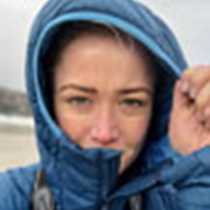“Wind gusts of 45 knots and a steady wind speed of 40 knots…” When a 6:45 a.m. morning announcement in South Georgia sounds like this, you had better hope to find a “Good Cove” to take shelter within. Fortunately for all of us on board the National Geographic Explorer, Godthul is exactly that. This sheltered inlet offers some of the best protection in South Georgia when the infamous frontal systems of the Southern Ocean begin their assault on this remote island, as happened this morning.
Named by the early Norwegian sealers and whalers, Godthul does translate as “Good Cove” and it is a striking expanse of snow-capped mountains and secreted small coves and caves. While the seas along the outer coastline of South Georgia were whipping up a large swell, the little inlet of Godthul was lake-like in comparison. Strong gusts of wind were still buffeting off the tops of the surrounding rolling mountains, whirling up williwaws and causing the miniature waterfalls around Godthul to flow upwards instead of downwards! Overall, however, Godthul was a tranquil haven and one of the few South Georgia had to offer us this morning.
Not to be outdone by the weather, the hardy souls on board were resolute to get outside to enjoy one of the final opportunities to experience South Georgia. Hikers set off up the hillsides, photographers rambled the shoreline with photo instructor David Cothran, and many chose to partake in a Zodiac cruise, taking in the impressive landscape of Godthul and a few strong blasts of wind on route.
One place you are certain to escape the strong wind gusts is underwater. Our undersea team, Paul North, the undersea specialist, and Erin McFadden, the expedition diver, took every opportunity to dive and record on camera what was hidden beneath the cryptic surface waters. Today as the winds were racing across the cove, they descended into the calm of the kelp forest. These forests of giant bladder kelp are an ecosystem in their own right. We’ve seen the long fronds on the surface of the water at many locations we’ve visited around South Georgia. And we’ve watched our Zodiac drivers battle to get through some of the really thick stuff! Without the undersea footage we would be left wondering what it looked like below the ceiling of fronds.
The reason they’re called kelp forests becomes immediately obvious when you get underwater. These large organisms grow up from their holdfast—a part of the kelp that looks entirely like an exposed tree root and serves as an anchor for the large stipe growing upwards from it. Growing up to three feet per day in the right conditions, the kelp grows towards the surface seeking light: As an algae it must photosynthesise and thus must be exposed to sunlight.
These are the largest and structurally most complex algae and as part of the marine flora, kelp provides not only matter for fauna to graze on, but also a hiding place within which animals can seek protection from predation. It is also a nursery habitat for juvenile animals such as fish, and both flora and fauna use the kelp as a substrate. Even the fur seals make the most of the kelp, using it for what looks to us like a playground as they dart through.
This suite of uses makes a kelp forest a fascinating dive site, and at Godthul today the undersea team found a seafloor littered with marine invertebrates amongst, on, as well as nestled within the kelp and its holdfasts. Enjoying the footage Paul North captured with a drink in hand at our evening Recap is a far more enjoyable and warmer way to witness the impressive underwater environment of South Georgia than plunging into these frigid waters ourselves!
As ever on board National Geographic Explorer, a day is always to be filled and indeed as we left the calm but windy expanse of Godthul and sailed out into the swell, we had one more destination in mind before setting sail for the Falkland Islands.
The Nordenskjold Glacier became a fitting finale to our time here in South Georgia. This expanse of ice rises out of the water and extends for almost 3km and those brave enough to face the blustery conditions and snow piled out for one last Zodiac ride in South Georgia. Watching towering pillars of ice calve from the glacier face and shatter into the water below from a Zodiac was certainly an enthralling and authentic experience! It will be hard to leave this island behind.







